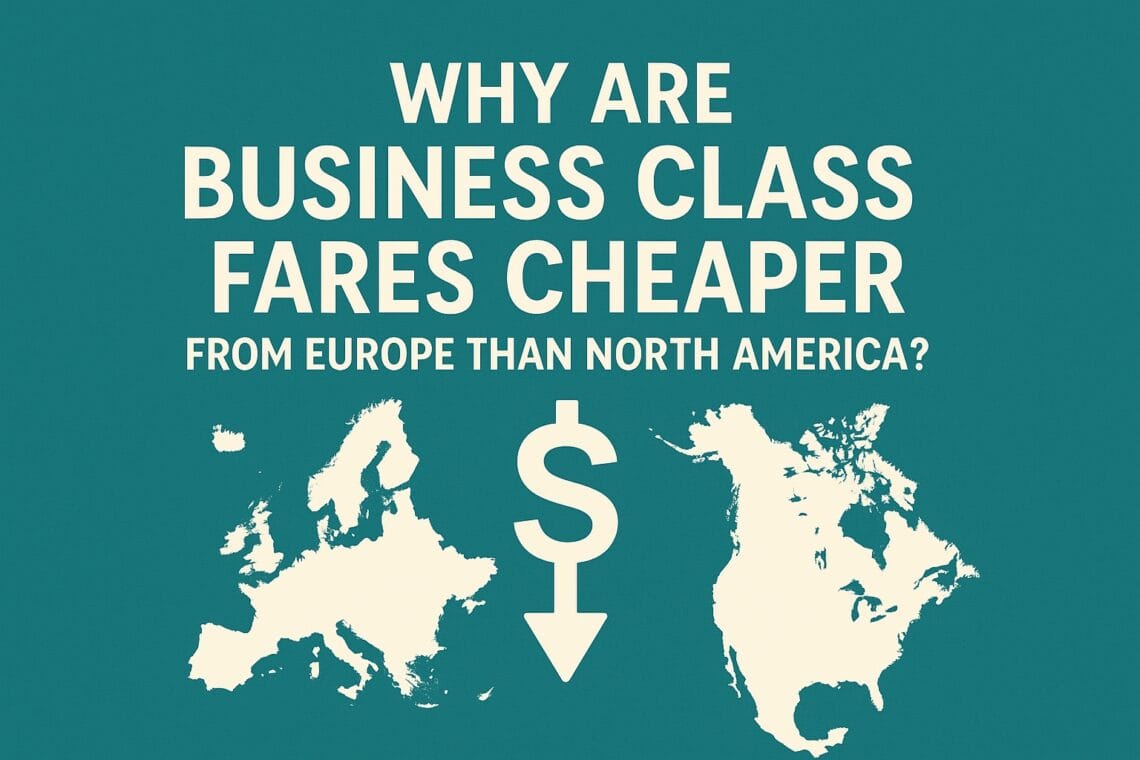
Why Are Business Class Flights Cheaper from Europe Than from the US?
If you’ve ever searched for business class flights from the US and noticed that tickets from Europe are much cheaper, you’re not imagining it. Many American travelers wonder why flying from Paris, Milan or Oslo can cost half as much as departing from New York, Chicago, or Los Angeles.
As a website that has monitored cheap business class fares for many years, we regularly see significant price differences depending on the origin point of the flight. Let’s take a closer look at why business class flights are often cheaper from Europe than from the United States.
Business Class Demand: U.S. vs. Europe
One of the biggest reasons for higher U.S. business class prices is simple economics. American travelers generally have higher disposable incomes compared to many Europeans. In addition, most U.S. workers receive fewer annual vacation days, often just two to three weeks, compared to four to six weeks for most Europeans.
As a result, U.S. travelers tend to take fewer trips each year, but when they do, they are willing to spend more for comfort and convenience. Airlines recognize this and price business class fares accordingly.
In contrast, European travelers take more frequent holidays, often choosing shorter trips or more competitive fares. This behavior creates intense competition among European airlines, which helps push prices down on flights departing from Europe.
Airline Pricing Strategies & Corporate Travel
Airlines set fares using complex algorithms that factor in demand, competition, and local market behavior. In North America, airlines often focus on business travelers whose companies cover the cost of premium travel. Since these travelers are less price-sensitive, airlines can maintain higher prices from U.S. departure points.
In Europe, the mix of passengers is different. Many business class travelers are self-funded professionals or leisure travelers looking for a deal. This forces airlines to run more business class sales and promotions throughout the year to keep premium cabins full.
Competition Among Airlines
Europe’s long-haul market is extremely competitive. Legacy carriers such as Lufthansa, British Airways, Air France, Swiss, KLM, Iberia, and TAP Portugal go head-to-head with Gulf carriers like Qatar Airways, Emirates, and Etihad. This competition keeps fares low, especially from major hubs like Amsterdam, Oslo, Paris, Milan, and Madrid.
In the United States, competition is more limited on many international routes. With fewer airlines operating nonstop flights abroad, U.S. carriers can keep prices higher, particularly on high-demand routes to Europe or Asia.
Taxes, Fees & Fuel Surcharges
Taxes and surcharges also play a role. Some European countries add significant fees, such as the UK’s Air Passenger Duty, but even with those, overall fares often remain lower than in the USA.
Fuel surcharges are another factor. Certain European countries restrict excessive surcharges on departing flights, while U.S. carriers typically apply higher fees.
Currency and Local Buying Power
Airlines also adjust fares according to local market conditions. Economic factors such as currency strength, inflation, and purchasing power all influence ticket prices. A fare that seems fair for a U.S. traveler might be considered expensive in many European markets, leading airlines to lower prices in Europe to maintain demand.
Frequent Sales and Promotions in Europe
European carriers regularly launch business class sales that target leisure and self-funded business travelers. These sales often feature long booking windows, sometimes six to twelve months in advance, making it easier to plan ahead and secure lower fares.
By comparison, North American airlines focus more on loyalty programs, last-minute availability, and corporate contracts, with fewer broad discount promotions.
Why This Matters for U.S. Travelers
If you live in the United States, these pricing differences can open opportunities. Many frequent flyers book “positioning flights” to Europe to take advantage of cheaper long-haul fares. For example, it’s sometimes possible to fly from New York to Dublin separately, then continue a discounted business class trip from Europe to Asia or Africa, saving thousands overall.
It requires more planning and flexibility, but for those who enjoy premium travel, it’s one of the most effective ways to experience cheap business class flights without paying U.S. prices.
Our Experience After Monitoring Thousands of Deals
After many years of tracking premium cabin pricing, we can confidently say: business class fares departing Europe are on average cheaper, but not always. There are excellent deals out of USA and Canada as well, but the most frequent and deepest discounts usually start from Europe.
If you prefer to find deals departing the United States or Canada, we regularly post them here: Business Class Deals from North America.
FAQ
Are business class tickets always cheaper from Europe?
No, but often they are. Prices from Europe can regularly be 20–50% lower than departures from the United States for the same route.
Why do airlines allow such pricing differences?
Airlines adjust pricing based on local demand, competition, and traveler behavior. Europe often has more price-sensitive travelers, forcing airlines to offer more competitive fares.
If you don’t want to monitor the deals yourself, simply subscribe to our free newsletter to get the latest cheap business class deals directly in your inbox.
Note: All deals are personally verified and bookable directly with airlines or reputable travel partners. Prices and availability can change quickly, we never sell flights ourselves.
